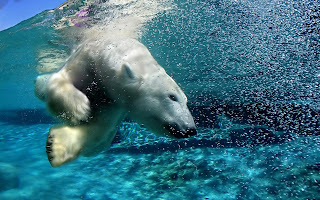General Info :
Bears are mammals of the family Ursidae. Bears are classified
as caniforms, or doglike carnivorans, with the pinnipeds being their closest
living relatives. Although only eight species of bears are extant. Common
characteristics of modern bears include large bodies with stocky legs, long
snouts, shaggy hair, plantigrade paws with five nonretractile claws, and short
tails. Bears use shelters, such as caves and burrows, as their dens; most species
occupy their dens during the winter for a long period (up to 100 days) of sleep
similar to hibernation.
Physique :
Bears are generally bulky and robust animals with relatively short legs.
Adult male Kodiak bears average 480 to 533 kg (1,100 to 1,180 lb) compared to
an average of 386 to 408 kg (850 to 900 lb) in adult male polar bears, per the Guinness Book of World Records. The
smallest bears are the sun bears of Asia, which weigh an average of 65 kg
(140 lb) for the males and 45 kg (99 lb) for the females, though
the smallest mature females can weigh only 20 kg (44 lb). All
"medium"-sized bear species (which include the other five extant
species) are around the same average weight, with males averaging around 100 to
120 kg (220 to 260 lb) and females averaging around 60 to 85 kg (130 to 190
lb), although it is not uncommon for male American black bears to considerably
exceed "average" weights. Head-and-body length can range from
120 cm (47 in) in sun bears to 300 cm (120 in) in large
polar and brown bears and shoulder height can range from 60 cm
(24 in) to over 160 cm (63 in) in the same species,
respectively. The tails of bears are often considered a vestigal feature and
can range from 3 to 22 cm (1.2 to 8.7 in).
Diet :
Some bears will
climb trees to obtain mast (edible vegatative or reproductive parts such as
acorns); smaller species that are more able to climb include a greater amount
of this in their diets. One exception is the polar bear, which has adopted a
diet mainly of marine mammals to survive in the Arctic. The other exception is
the giant panda, which has adopted a diet mainly of bamboo. Stable isotope
analysis of the extinct giant short-faced bear shows it was also an exclusive
meat-eater, probably a scavenger. The sloth bear, though not as specialized as
the previous two species, has lost several front teeth usually seen in bears, and
developed a long, suctioning tongue to feed on the ants, termites, and other
burrowing insects they favour. At certain times of the year, these insects can
make up 90% of their diets. All bears will feed on any food source that becomes
available, the nature of which varies seasonally. When taking warm-blooded
animals, bears will typically take small or young animals, as they are easier
to catch. However, both species of black bears and the brown bear can sometimes
take large prey, such as ungulates. Often, bears will feed on other large
animals when they encounter a carcass, whether or not the carcass is claimed
by, or is the kill of, another predator.
Distribution :
Bears are primarily found in the Northern Hemisphere, and with one exception,
only in Asia, North America and Europe. A single species, the spectacled bear,
is native to the Andean region of South America. The Atlas bear, a subspecies
of the brown bear, was the only bear native to Africa. It was distributed in
North Africa from Morocco to Libya, but has been extinct since around the
1870s. The most widespread species is the brown bear, which occurs from Western
Europe eastwards through Asia to the western areas of North America. The
American black bear is restricted to North America, and the polar bear is
restricted to the Arctic Sea. All the remaining species are Asian. With the
exception of the polar bear, bears are mostly forest species. Some species,
particularly the brown bear, may inhabit or seasonally use other areas, such as
alpine scrub or tundra.
























No comments:
Post a Comment